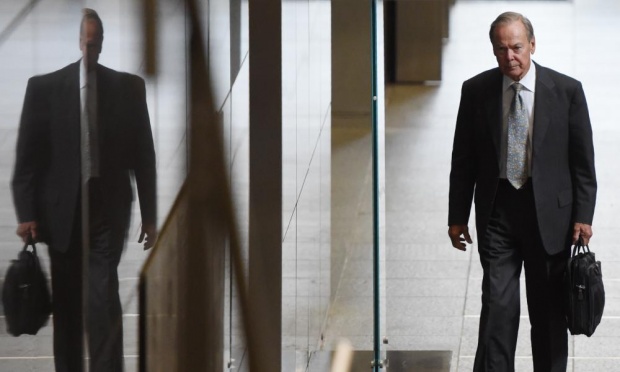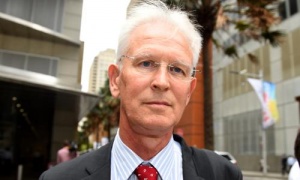Old Boys of Knox Grammar, like Me, Will Always Be Marked by How Close We Came to the Abuse There
The Guardian
The central question the royal commission into institutional responses to child sexual abuse has been driving at is the right one: whether the legendary former headmaster of the school, Ian Paterson, who led the place from 1969 until 1998, put the school’s reputation ahead of the wellbeing of abused students. The correct question, posed wrongly, because Knox Grammar during Paterson’s tenure was an extension of the man’s ego. The school’s reputation was not something external that could be defended or prioritised. Even a cursory look over the school’s obsessive self-chronicling, let alone the transcripts of the commission, shows how omnipresent Paterson was: among other things, he edited (and editorialised in) the school magazine, caned the boys, taught classes, was patron of the old boys’ association, and directed the school musicals. He derived his authority from this ability to be everywhere, and his legacy still effectively ran the school long after he had moved on to bigger and better things – including as a consultant to Yeshiva College, Bondi, one of the Jewish schools previously investigated by the commission. It was said that you couldn’t change a lightbulb at Knox without Paterson’s involvement. This raises the natural question, the core question in all royal commission hearings: what did he know? On 4 March, Paterson admitted to the commission that he knew, from at least 1986, that Adrian Nisbett was touching the groin and penis of students. That he knew, from at least 1987, that Craig Treloar had shown pornography to schoolboys. That he knew, from at least 1992, that it was suggested that Barrie Stewart had molested at least one student. That he knew, from 1988, that Christopher Fotis was suspected of wearing a balaclava to disguise his identity while he sexually assaulted a student in the boarding house. That he knew, from 1992, that it was alleged that another teacher, ARZ, had been sleeping with a student. He also gave evidence admitting to misleading a police officer, who came to see him in 1996 after an anonymous tipoff. He recanted this evidence on 6 March, saying instead that the school had in place an “outstanding” system of pastoral care, and “that this system failed to reveal the victims of abuse is extraordinary, given so many likely outlets for help” – yearmasters, counsellors, prefects and so on. How strange that, under Paterson, this system never once resulted in a call to police, or in a career being ended. Stranger still that senior staff in this system do not remember being trained in child protection, despite mandatory reporting legislation being in force for non-government schools from 1988. The internal investigation into Adrian Nisbett was placed in a file and never seen again A sophisticated system leaves a paper trail. Not this one. Paterson told the commission he was “sparse” in his notekeeping. The records show that was not the case when giving praise: he penned glowing references for Damian Vance, who would go on to be convicted of indecent assault, and Fotis. In 1995 he thanked Nisbett in writing for his “especially wise” counsel over the years, with the ominous addition: “before too late (!)”. Other documents went missing: an internal investigation into Nisbett, conducted in 1986 by the then Knox general duties master and retired police officer Stuart Pearson, recommended he be removed from the boarding house and prohibited contact with students beyond the classroom. It was placed in a file and never seen again; Nisbett had been working in the room that held the files. A few years later he was moved to Kooyong boarding house (although Paterson contends he was not responsible for students). And Treloar, after it was known he had shown students pornography and allegations of abuse were made, was allowed to choose when he would take six months of unpaid leave as punishment. Paterson arrived at Knox a young, stern headmaster, set on reform. How did he become the embodiment of the school? He started there 1961, as a teacher and resident master of MacNeil boarding house, left in 1964, and returned five years later to become the headmaster. During those few early years many of the dramatis personae of the school’s next half century were together: Rex Ward, who would become deputy headmaster and boarding master, was school captain in 1961, and a resident master with Paterson; John Turnbull, who would go on to be the school’s deputy principal, graduated in 1960 and was back by 1962, also in the boarding house. Bruce Carter, who would also be a deputy headmaster, returned immediately after graduating in 1961 to be a resident master at MacNeil. “Carefree with no worries about food and accommodation, but stringent in exacting study schedules, we grew together, forever,” Paterson wrote in an obituary in the December 2014 issue of Knox’s school magazine, the Thistle. Together, forever. While one official history of the school records the hope that Paterson would clear out some of the “settled” staff of the 1940s and 50s, he instead entrenched the system of old boys’ rule. On 6 November 1987 in the school newsletter Paterson informed readers: “You will be interested to know that there are 12 Old Boy teachers at Knox.” Treloar was one of them, hired without an interview to be a boarding master. Other teachers whose criminal records were unknown to the school were hired as a result of the mates’ policy. Nisbett, another old boy who went on to become a teacher, would have been a younger student in Paterson’s early years, graduating in 1967. John Weeks, the current headmaster, told the commission he was rumoured to be “a protected species” because of his closeness to Paterson. But that was just the way it was, back then. Was Knox a world unto itself? Was it insular? “Well, to a certain extent, yes,” Paterson said during questioning. So insular that it took until after Paterson’s departure for things to unravel, thanks to Nisbett. We know from the commission that, under Paterson’s system, records of staff misconduct were kept in a “black folder” in the headmaster’s office. The commission also heard that when Peter Crawley became headmaster in 1999, Paterson, in the course of handover meetings, only mentioned its existence in passing, saying: “If anything awkward, embarrassing arises, you will find the file will give you all the detail you need.” What Crawley discovered, when he found the folder two or three days into his headmastership, left him “aghast” – scraps of paper, handwritten notes, useless without the knowledge in his predecessor’s head.
Crawley was a technocrat in every sense of the word. Under his leadership, laptops and smartboards were suddenly everywhere and the desks turned into hexagons. The prefecture was diminished in status as the school was flooded with new titles and awards aimed at improving self-esteem and reducing the exclusivity of the few existing positions. Programs for gifted students were instituted to counterbalance the prestige of the school’s sports regime. And new classroom capacity was added, in the form of some utilitarian demountables that were, long after he left, known by students as the Crawley Centre. Agency was slowly devolved to the boys and the new headmaster’s approach was typified by one of his first acts upon taking over: removing Paterson’s old cane from the headmaster’s office – and sending it to the archives rather than the rubbish tip. Upon arriving, Crawley heard rumours about Nisbett and in this technocratic mode did his “essential due diligence”. There was nothing on Nisbett’s file – the Pearson report was no longer there – or in the black folder. He began to ask staff and hit an “absolute blank wall”. Crawley told the commission he went “very directly to Rex Ward, who was the deputy headmaster and had been in boarding in the late 70s and had been at the school for a very long period of time”. Ward, a Knox lifer, had performed a variety of senior roles in the school. Crawley was blunt when giving evidence: “[Ward] simply said to me he knew nothing.” John Turnbull, another stalwart, had been deputy headmaster before Ward. Crawley approached him too, telling the commission he “was very clear about it. He said he knew absolutely nothing”. Ward and Turnbull both left the school during my time there. It was not until 2003 that the question of abuse was reopened, when a complaint was raised with the school after Nisbett took a student back to his home for dinner, allegedly plied him with alcohol and cigarettes, and hugged – in Nisbett’s words, “clasped” – him. The inquiry by the independent investigator Graeme Wilson that followed did not find abuse had occurred; Crawley issued Nisbett with a warning. Crawley was seen by many in Knox’s conservative milieu as too radical and his time as headmaster ended in 2004. As students, we were dimly aware of personality conflicts between him and the school council. His departure was a consequently a moment of either pathos or schadenfreude, depending on where you stood. He was replaced by John Weeks, a clean, prestige-focused “building” headmaster. The school’s image became glossier and we heard a lot more about how Knox was a “champion school”. Events grew in size and celebrity – Human Nature and Paulini headed up the 80th birthday celebrations – and Weeks was smiling his Larry Emdur smile all over the school. I found him maddening and still remember the way he reeled me in for the handshake at my final speech day, as his eyebrows climbed up his face. To his credit, at the commission hearings he diagnosed the problem faced by the two post-Paterson headmasters clearly: There were those who were very loyal to the past, very loyal to 30 years of ‘the way we do things around here’, very loyal indeed ... [Crawley’s] role was to try and lift Knox into the 21st century, and when he came he was opposed by the boarders, the boarding housemasters, who saw their position threatened; he was opposed by the prep, which was on a separate campus. Then he had to fight off the internal issues and tensions within his own council as he tried to bring about change.” Nearly the entire establishment opposed reform. Weeks understood that and “drew a line in the sand” with the school council. He saw the solution as being in the model of the cruellest Christian reformers: to strip the altars clean, break the idols and begin again. He had heard rumours about Nisbett before he arrived at Knox and returned to Crawley’s 2003 investigation, reappointing Wilson to investigate further. Nisbett was moved into a non-teaching role while 17 allegations were investigated. Wilson’s second report found that seven of these were substantiated and Nisbett resigned. He purged the boarding houses of their staff, bulldozed them and replaced them with a “best-practice” boarding centre. That was part of a cyclopean building program that transformed the school, burying the ruins under clean new buildings. Boarding masters must now be married and work in highly scrutinised husband-wife teams. Reactionary or not, Knox would no longer have to tread sensitively around issues of homosexuality, as was the case with Nisbett. Weeks told the royal commission he was proud that under him the teaching staff became 55% female, 45% male. Weeks’s reformation tore through the school in just under a decade: only three pre-2004 teachers now remain at the preparatory school, and 23 from 200 at the senior school. “This is root-and-branch change management,” he told the commission. “… if the people won’t change, you get new people.”
Weeks, despite his zeal, did not sweep it all away, and further mistakes were made. Treloar was still on the books until his arrest in 2009. The commission heard that Weeks was made aware of the teacher’s history in 2007 – the extent of what he was told was a matter of contention – but he did not report him to police or sack him, because, the headmaster maintains, it would have been difficult “on industrial grounds”. Treloar had already abused another child, Angus Ollerenshaw, by this stage – in 2002. Weeks did not refer the contents of Wilson’s second report to the police, on advice from the New South Wales ombudsman, who later admitted it was a mistake not to advise the school to do so. Nevertheless, Knox’s child abuse decades ended in 2009 with the long overdue involvement of police. There are apologies to be made and settlements to be paid but these are less burdensome challenges for a headmaster to face. Ollerenshaw, in his testimony to the commission last week, said he was proud to wear the school uniform before the abuse that destroyed his life. Many of us were. I was, especially the uniform of the cadet unit, which was where felt most at home during my high school years. I was also proud of the friendships I still carry with me, including with some of my teachers. But it’s clear now that our experiences were just some of many alternate histories of the school. Our memories belong to Knox too, now being rewritten according to the testimony of ageing school authorities we perhaps never even met. There was a certain texture to life at Knox that made the school what it was: the immediacy of history and tradition; the presence of old boys in the senior staff, on the sports field, in the cadet unit, and at the pub; the donnish attitudes of some teachers; and the benign stance taken towards eccentricity. It was the insular sense of privilege, the ebb and flow of generations of students marked by destiny, the school’s desire to produce and own its students’ achievements. These values also created an environment where child abusers could thrive. And what they did should not be construed as an exception, a blot on an otherwise good institution. So when some old boys say they can’t square the Paterson from the commission with the Paterson they knew, their nostalgia is misplaced. It is also, as I imagine the Paterson of those days would have said, contrary to the school’s values of self-restraint and discipline. As he wrote in 1995, in the final years of his headmastership: The serial killer, the children high on drugs, the clergyman who kills an abortionist – each can have high self-esteem and feel very good about themselves while they commit their abominations. Modern psychologists attack feelings of guilt as disruptive to sound mental health. No wonder so many of those who flout the moral imperatives of society stare vacantly, even challengingly, from their courtroom boxes. Guilt is absolutely necessary as a prick to conscience, and a guide to moral behaviour. Without it, unbridled emotions race to their antisocial conclusions.” The schooldays of those of us who thrived at Knox were lived at a great remove from the ones who suffered, for some of whom the sight of Barrie Stewart, or Craig Treloar, still triggers memories of their abuse. Today, thanks to the royal commission’s work, we have no option but to acknowledge the truth of what went on there, and are consequently given the agency to form honest opinions about the place. Knox Grammar no longer has, to use Paterson’s language, the “pricks” – and the former headmaster is the one staring vacantly, even challengingly, from the box. Whether we feel guilt or shame, or wonder why some were preyed upon while others remained ignorant – those emotions no longer belong to the old man and the school he built around him. How could they? As Weeks said on Friday: “That school no longer exists any more.”
|
.
Any original material on these pages is copyright © BishopAccountability.org 2004. Reproduce freely with attribution.


